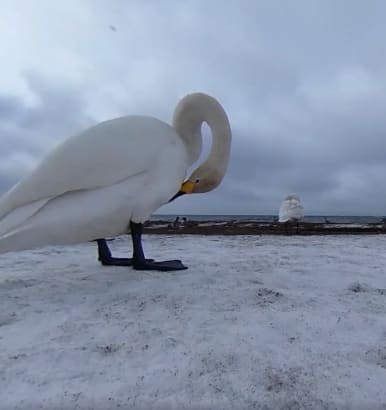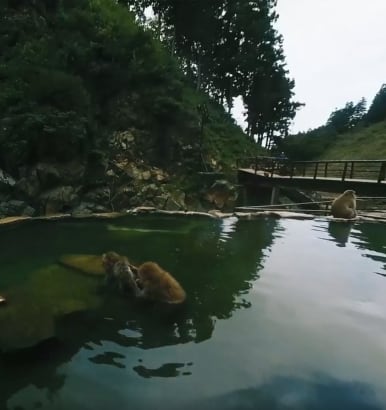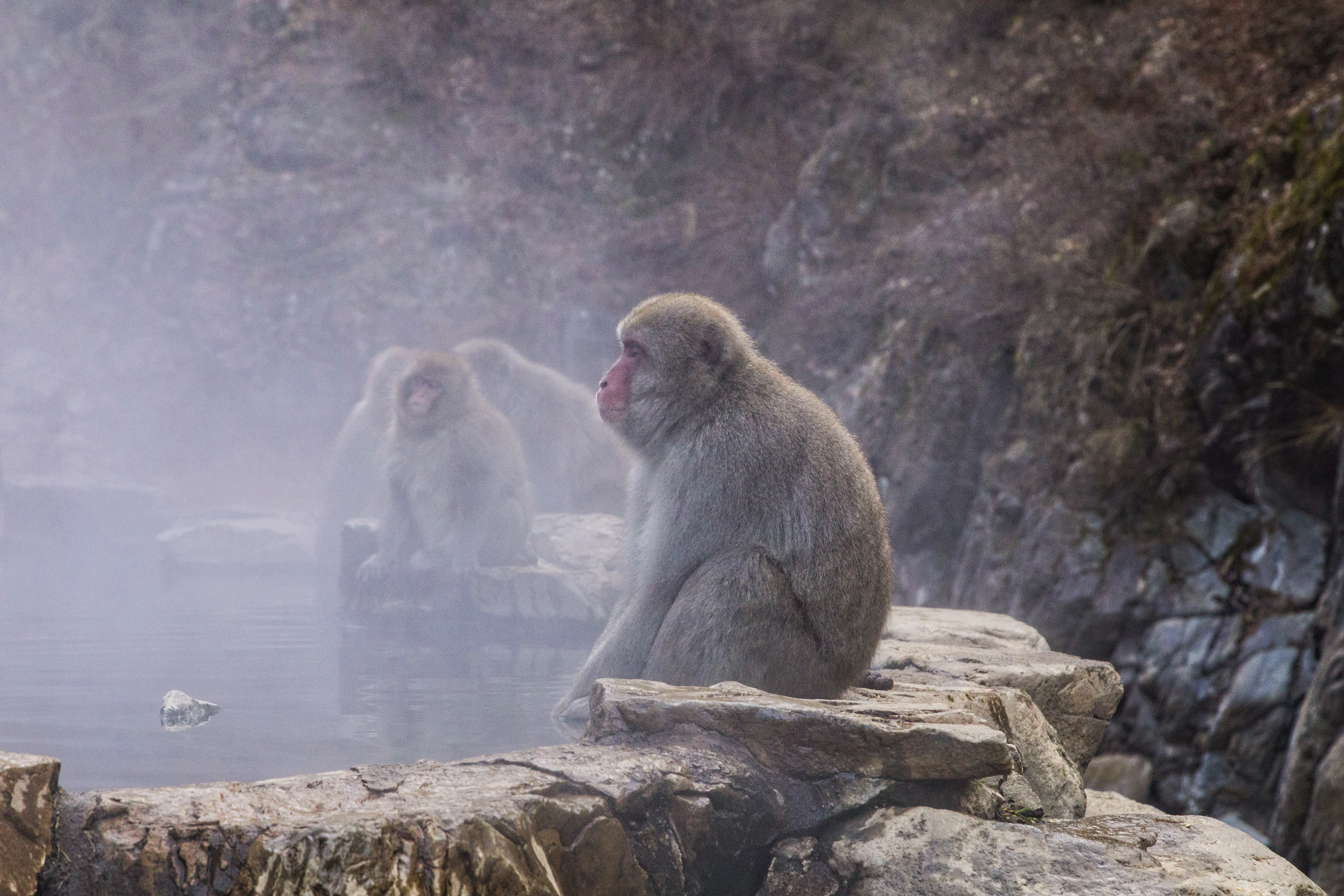
A Japanese macaque bathing at Jigokudani Yaen-Koen
Mammals
Your first encounter with Japan’s wildlife may be the Japanese macaque, a fairly common sight in some of the country’s popular tourist destinations. You’ll find these snow monkeys bathing in hot springs at Jigokudani Yaen-Koen (Jigokudani Snow Monkey Park) in Joshin’etsukogen National Park in Nagano or playing on the mountain at Iwatayama Monkey Park near Kyoto. These playful creatures live in wide-ranging habitats, from the deciduous forests in central and northern Japan to the warmer evergreen forests in the south. Another mammal inhabiting Japan’s forests is the Japanese serow, a goat-antelope. This curious-looking creature is endemic to the country and is considered a national symbol of Japan. It can be spotted in many national parks on Japan’s main island of Honshu.
Hikers in Japan should be aware of bears. Asiatic black bears live on Japan’s islands of Honshu and Shikoku, and Ussuri brown bears, a subspecies of brown bears, are only found in Hokkaido. Bears are naturally timid animals and will stay away from humans when they sense them around, but if you take them by surprise, they may attack and cause fatal injuries. It is always best to be cautious, hike with a bear bell, and never approach the animals. Conservation groups, such as Picchio Wildlife Research Center in Joshin'etsukogen National Park, help create a border between the bears and humans to find a way to coexist at a safe distance.
Some of the rarer mammals in Japan include the Iriomote cat, a subspecies of the leopard cat. These elusive and extremely endangered species only live on Iriomote Island, and there are thought to be around 100 adults left. The Iriomote Wildlife Center works to protect these nocturnal felines, building public awareness, carrying out research activities and providing an emergency hotline if people find injured Iriomote cats due to road accidents. Another of Japan’s endemic animals is the dark-furred Amami rabbit, which is only found on Amami Oshima and Tokunoshima islands in Amamigunto National Park. This endangered species is considered a living fossil because of its similarity to ancient rabbits that once inhabited the mainland.
More commonly found mammals include Japanese deer, stoats, tanuki (raccoon dogs), Siberian flying squirrels and the Ezo red fox, a larger relation of the Japanese red fox. These species can be spotted in northern parks, including Shiretoko National Park and Daisetsuzan National Park.
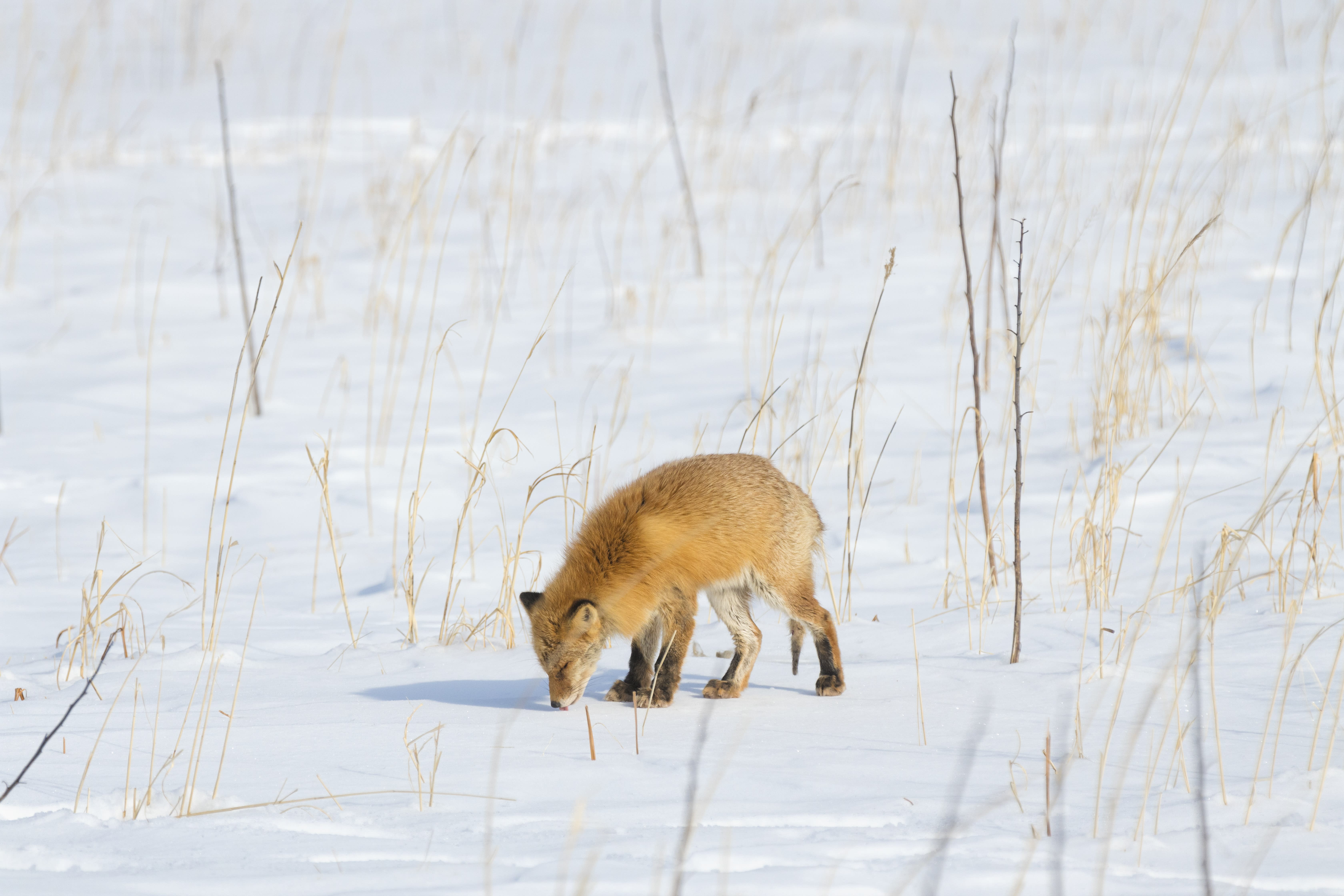
An Ezo red fox in Shiretoko National Park
Birds
Japan is a real treat for bird watchers. One of the most iconic sightings is the elegant courtship dance of red-crowned cranes seen in snowy Kushiroshitsugen National Park between February and March. According to recent estimates, there are approximately 1,650 red-crowned cranes in Japan, and their numbers are growing due to considerable conservation efforts. Kushiroshitsugen National Park is their primary habitat. Around half of Japan’s bird species can be found in Hokkaido, many of which migrate from Siberia during the winter. Elsewhere in Japan, conservation efforts have revived Japan’s once extinct population of Oriental white storks to around 220 birds. These white birds with black wings live in Toyooka, in San'inkaigan National Park, in northwest Kyoto Prefecture.
Further north, off the coast of Shiretoko National Park, you can find the Steller's sea eagles, a powerful-looking bird that migrates to the area from their breeding grounds in eastern Russia. The Shiretoko Peninsula is also home to the largest owl in the world, the Blackiston fish owl, a rare species that feeds on river fish.

Steller's sea eagles perch on drift ice in the Sea of Okhotsk
The remote Ogasawara Islands in Ogasawara National Park are a great place to spot endemic species. Birders seek out the Bonin honeyeater, a songbird endemic to Hahajima island. The islands are also an important breeding ground for Bryan’s Shearwater, a globally-threatened species.
Okinawa is a lesser-known paradise for birding. The most coveted sighting is the Okinawa rail, an elusive, flightless bird that was only discovered in 1981. It is endemic to the forests of Yambaru National Park. The rare Pryer’s woodpecker is another endemic species that inhabit these same forests.
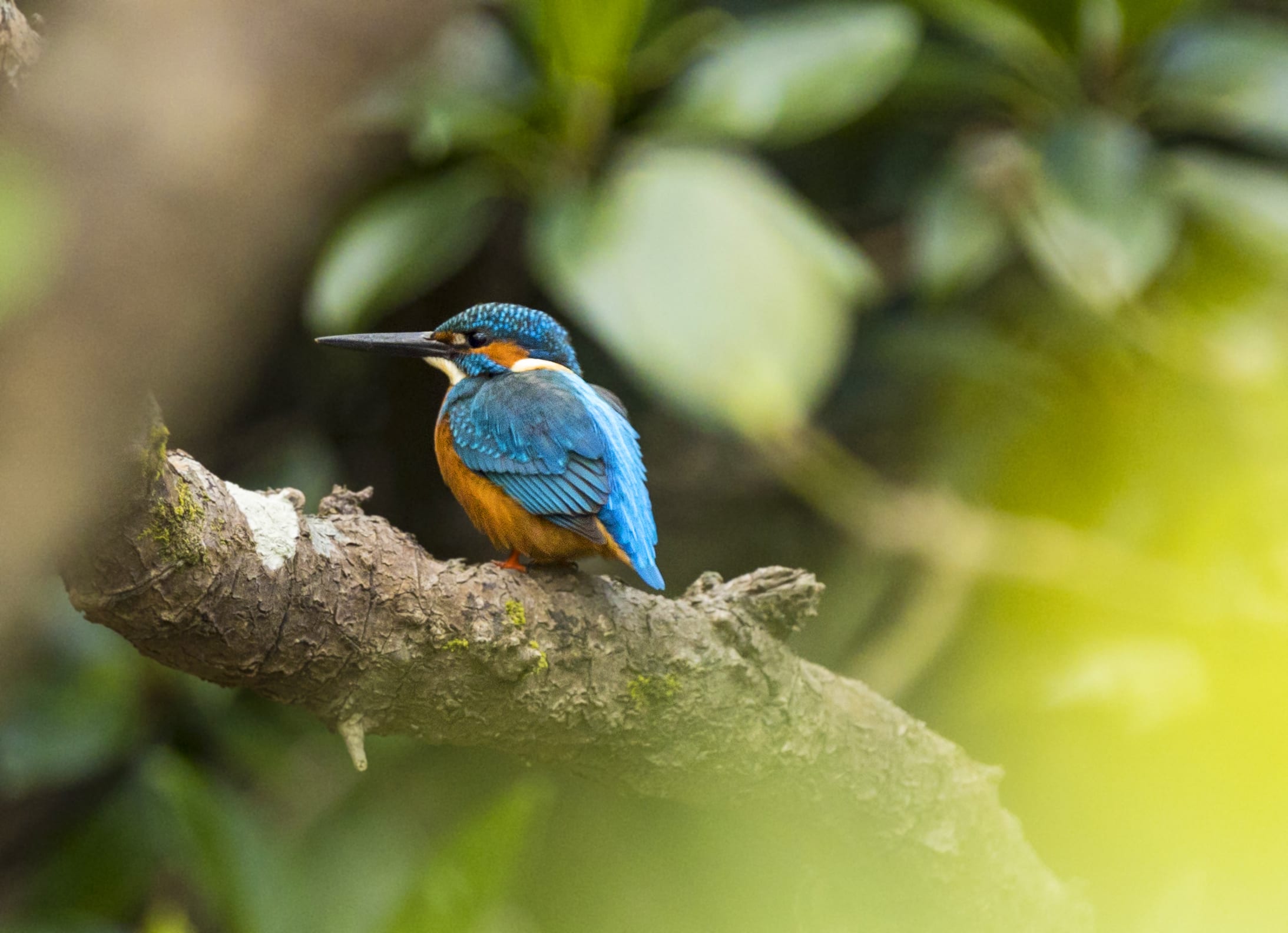
A common kingfisher in the mangroves of Amamigunto National Park
Reptiles and Amphibians
Venture off Japan’s coasts to see five of the world’s seven sea turtle species, including loggerhead, green turtles, hawksbill and leatherback. There are opportunities to swim with these beautiful beasts along much of Japan’s southern coastline. You can snorkel among them as they nibble on seaweed near the coast of Tokashikijima, in Keramashoto National Park, and along the Iriomote-Ishigaki National Park coastline, where loggerhead, hawksbill and green turtles swim among the coral reefs. In Ogaswara National Park, green turtles lay eggs from May to August, which hatch from July to October. On Nagatahama Beach in Yakushima (Island) National Park, hundreds of loggerhead turtles lay eggs from May to August.
Other reptiles you can spot in Japan’s national parks include the Ogasawara snake-eyed skink, an endemic lizard species, and snakes, such as the Japanese keelpack.

A green sea turtle swimming in the waters of Keramashoto National Park
Marine animals
Japan's marine life is quite varied, with whales, dolphins, porpoises, sharks and fish inhabiting the archipelogo's waters. Its subtropical waters in the south are home to coral reefs that teem with sea turtles, clownfish, butterflyfish. In Iriomote-Ishigaki National Park, you can even spot manta rays in the shallows of Ishigaki island, where there are plenty of places to snorkel and dive. Kabira Bay is a beautiful place to explore beneath the waves without getting your feet wet. Swimming is prohibited, but glass-bottomed boats and kayaks allow you to peek into this other world, watching colorful fish dart between corals. This delicate environment is under threat from climate change and pollution, but local fishers, farmers, tourism firms, scientists and the government formed the Sekisei Lagoon Nature Restoration Committee to help preserve these precious ecosystems.
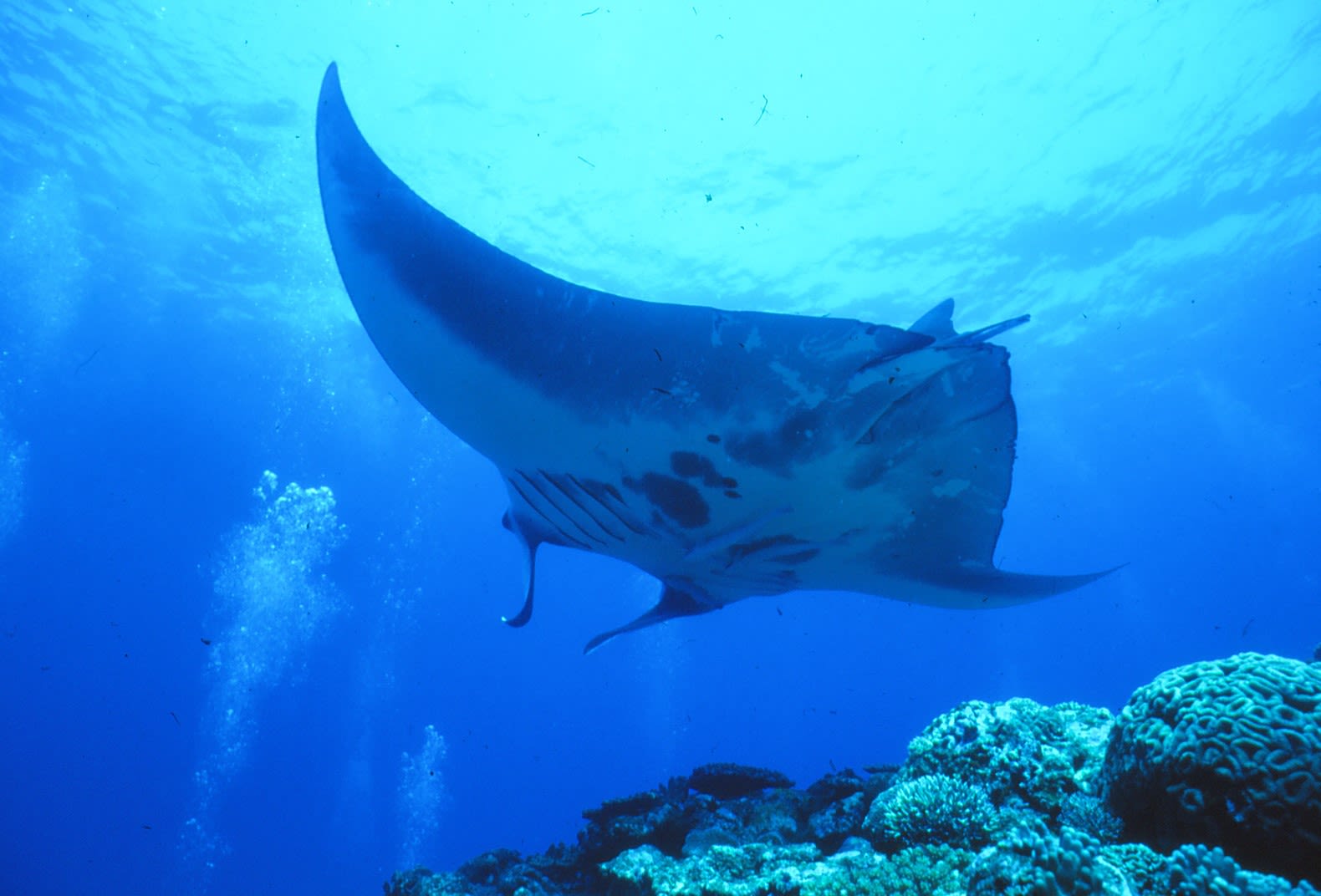
A reef manta ray glides below the surface in Iriomote-Ishigaki National Park
The remote Ogasawara Islands of Ogasawara National Park are another favorite with divers and snorkelers, but you can spot its most impressive sea life from a boat. Humpback whales visit between February and April and sperm whales between May and November. You can also catch sight of spinner and bottlenose dolphins year-round.
Closer to Japan’s mainland, much of the eastern coastline is affected by the warm Kuroshio Current, a major ocean current that begins off the Philippines. This current makes the waters of Kushimoto in Yoshino-Kumano National Park warm enough to allow extensive coral communities to thrive—unusual for an area this far north.
Even further north, the chilly northern waters of Shiretoko National Park in Hokkaido are home to Steller's sea lions, North Pacific giant octopus and smooth lumpsuckers, which makes for fascinating diving excursions that are a complete contrast to southern Japan.

A green sea turtle swimming off the coast of the Ogasawara Islands










